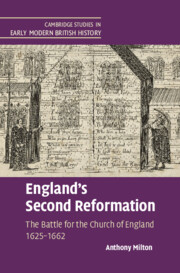Book contents
- England’s Second Reformation
- Cambridge Studies in Early Modern British History
- England’s Second Reformation
- Copyright page
- Dedication
- Contents
- Acknowledgements
- Abbreviations
- Introduction
- Chapter 1 An Unresolved Reformation
- Chapter 2 Situating the Laudian Reformation
- Chapter 3 Responses to the Laudian Reformation
- Chapter 4 The Abortive Reformation, 1640–1642
- Chapter 5 The End of Episcopalian Reformation
- Chapter 6 Reformation by Negotiation
- Chapter 7 The Westminster Reformation and the Parliamentarian Church of England
- Chapter 8 The Royalist Church of England, 1642–1649
- Chapter 9 Alternative Reformations, 1649–1653
- Chapter 10 The Cromwellian Church
- Chapter 11 Episcopalian Royalism in the 1650s
- Chapter 12 Failed Reformations, 1659–1661
- Chapter 13 The End of Comprehensive Reformation and the Caroline Settlement
- Conclusion
- Index
Chapter 7 - The Westminster Reformation and the Parliamentarian Church of England
Published online by Cambridge University Press: 05 October 2021
- England’s Second Reformation
- Cambridge Studies in Early Modern British History
- England’s Second Reformation
- Copyright page
- Dedication
- Contents
- Acknowledgements
- Abbreviations
- Introduction
- Chapter 1 An Unresolved Reformation
- Chapter 2 Situating the Laudian Reformation
- Chapter 3 Responses to the Laudian Reformation
- Chapter 4 The Abortive Reformation, 1640–1642
- Chapter 5 The End of Episcopalian Reformation
- Chapter 6 Reformation by Negotiation
- Chapter 7 The Westminster Reformation and the Parliamentarian Church of England
- Chapter 8 The Royalist Church of England, 1642–1649
- Chapter 9 Alternative Reformations, 1649–1653
- Chapter 10 The Cromwellian Church
- Chapter 11 Episcopalian Royalism in the 1650s
- Chapter 12 Failed Reformations, 1659–1661
- Chapter 13 The End of Comprehensive Reformation and the Caroline Settlement
- Conclusion
- Index
Summary
Chapter 7 traces the emergence of the Reformation implemented by the parliamentarian side in the Civil War. After noting the ambiguous status of the Westminster Assembly, the chapter analyses the drawing up of the Westminster Confession, the Directory for Public Worship, the Catechisms and the form of Presbyterian church government. In each case, it is argued that these represented more sweeping changes than the limited reforms originally contemplated by Parliament. But in each case, it is also demonstrated that the new formularies reflected many pre-war ideas and forms, while the orthodoxy of the Thirty-nine Articles and the Book of Common Prayer was still partly maintained. The reform of church government reflected the continuing determination of Parliament to retain ecclesiastical control. The second half of the chapter describes how these reforms were presented and understood, noting how shared discourses of anti-Laudianism, the covenant, fellowship with the foreign Reformed churches, providentialism, and biblicism both justified the changes but also created a language that could be turned against fellow parliamentarians. It is concluded that, for all the radical changes being contemplated and (partly) implemented, the Westminster Reformation encompassed a mixture of change and continuity with the pre-war church.
Keywords
- Type
- Chapter
- Information
- England's Second ReformationThe Battle for the Church of England 1625–1662, pp. 217 - 260Publisher: Cambridge University PressPrint publication year: 2021

